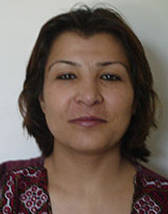The Role of Gender in Taliban and IS-K Recruitment: Evolving Trends
This Whitehall Report summarises the findings of a research project into the role of gender in extremist narratives and participation in violent extremism in Afghanistan.
The Taliban’s seizure of power in August 2021 prompted fears that Afghanistan would again become a haven for violent extremist organisations (VEOs). Of particular concern is Islamic State Khorasan Province (IS-K), the regional franchise of the Islamic State (IS) that is both a military and ideological foe of the Taliban. Afghanistan’s de facto authorities have sought to stamp out IS-K, but the latter retains a presence and is extremely active in the field of propaganda.
IS-K is notable in the Afghan context for seeking to appeal directly to women and girls. An IS-K publication in December 2022 called on foreign women to make the journey to Afghanistan to join them, suggesting they were trying to echo the success IS had in persuading women and girls to travel to Syria in 2013–19. Although the vastly different context in Afghanistan makes recruitment on that scale unlikely, the potential for gendered propaganda campaigns to attract women and girls to the IS-K fold is concerning.
IS-K’s outreach to potential female supporters also jars with common perceptions around gender and violent extremism (VE) in Afghanistan, where many people assume women play no role whatsoever in VE other than traditional domestic support functions. Research on VE seldom mentions women and girls, other than as victims, and detailed gender analysis of VEOs operating in Afghanistan is rare. This is despite the fact that women have played a range of roles in VEOs in Afghanistan, and that gender is a key feature of VEO ideology and propaganda in the country; for example, emotive calls to protect or avenge the honour of Afghan women feature heavily in recruitment materials, while fighters are often promised wives if they join the cause. The formulation of effective policies to counter VE requires a far better understanding of the ways in which VEOs manipulate gender norms and power relations between men and women to recruit and motivate their supporters.
This Whitehall Report summarises the findings of a research project into the role of gender in extremist narratives and participation in VE in Afghanistan. The project looked at the influence of social norms on involvement with VE, the varying roles that men and women play in Afghan VEOs, and the different methods used to recruit them. Given the lack of existing data on this topic, these broad themes were explored to create a baseline study that identifies numerous areas for further investigation. Key findings include:
- Although many respondents initially perceived that women played virtually no role in VEOs past traditional domestic support roles, a deeper look indicates that they had taken on other types of responsibilities. While direct female involvement in violence seems rare, both respondents and existing research note cases of women being involved in fundraising, scouting out attack locations, being trained in small arms use, recruiting and proselytising, among other activities.
- Expectations to be able to provide for and protect one’s family were considered to be among the most important reasons why men joined VEOs and influenced female relatives to do so. Respondents perceived this to be more important for most men than religious considerations. Women, by contrast, were thought to be more influenced by religious ideology to support or join VEOs.
- Research participants reported a notable growth in unregulated madrasa education for women since the mid-2010s, and a significant acceleration since the Taliban takeover in August 2021. While not all madrasas preach violent ideologies, respondents agreed that people already versed in extremist ideology presented an easier target for IS-K recruiters and that this wave of religious indoctrination had significantly impacted the context in which contemporary radicalisation is taking place. Furthermore, the departure or silencing of civil society voices since the Taliban takeover in August 2021 means there are currently no counterbalances to VE ideologies.
- The combination of increased literacy, access to technology, and being essentially imprisoned at home and deprived of many of their fundamental rights by the Taliban may push some young women towards IS-K. Research participants raised particular concerns that women active in non-violent but radical groups (which had significant space to organise and use their agency to proselytise under the previous government) might respond to Taliban restrictions by joining other VEOs. The prospect of some Afghan women getting more involved in a greater array of VEO activities appears possible given recent experience with other IS franchises, which have demonstrated the potential for radicalised women to reach potential new members via friendship networks and online.
- Both the Taliban and IS-K are highly active in online spaces and use messaging specifically aimed at women. IS-K uses online propaganda to call on women to join and support the group. Meanwhile, the Taliban appear to be using women and men posing as women against women’s rights advocates in online spaces. These efforts seek to delegitimise the women who oppose them by labelling them as anti-Islamic and anti-Afghan, and threatening them.
These research findings confirm that VEOs’ practices leverage gender discriminatory dynamics and frustrations to further their goals. International policymakers ignore this at their peril. The denial of women’s agency, heightened by the increased suppression of women’s rights and freedoms since the Taliban takeover, is being exploited by IS-K in Afghanistan. VEOs use claims that Afghan women are under threat and need protection to raise up potential recruits and gain local support, while VEOs then exploit those same women for their own gain.
This report provides recommendations for policymakers and donors that offer practical measures that would help push back on the spread of VEO propaganda and recruitment. For example, the monitoring of online propaganda in local languages should include a clear gender component whereby messaging targeting women and girls is specifically tracked, assessed and tackled.
Report translations
WRITTEN BY
Lucy van der Kroft
Middle East and Afghanistan analyst
Sonya Merkova
Human rights researcher
Horia Mosadiq
Researcher and human rights expert
- Jim McLeanMedia Relations Manager+44 (0)7917 373 069JimMc@rusi.org






